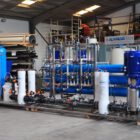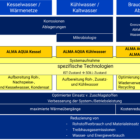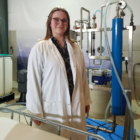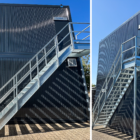Deposits are solid substances that deposit on the surfaces of pipes, heat exchangers, tanks or other water-bearing systems. These solids are formed by the precipitation of dissolved substances that crystallize or solidify as a result of chemical, physical or biological processes. In industrial water and wastewater treatment, deposits are a common problem as they can impede the flow, reduce the efficiency of systems and lead to increased maintenance costs.
Table of contents
Technical background
Deposits mainly form in systems in which water is heated, evaporated or compressed, or where differences in the concentration of dissolved substances occur. These processes promote the formation of solid substances that adhere to the surfaces of the systems. Deposits often consist of calcium carbonate (CaCO₃), magnesium salts, sulphates, silicates and other poorly soluble compounds.
In industrial practice, a distinction is made between different types of deposits:
Scale:
This type of deposit often occurs in boiler systems and heat exchangers in which water is heated or evaporated. With increasing temperatures and concentrations of calcium and magnesium ions, these ions crystallize as calcium carbonate or magnesium silicate and form solid deposits. These layers of scale act as an insulator and reduce the efficiency of heat exchangers by hindering heat transfer and increasing energy costs.Corrosion products:
Corrosion can cause metal ions to be released from pipes and system components, which then settle in combination with oxygen or other elements as oxide deposits or corrosion sludge. These deposits impair the water flow in the pipes and can lead to blockages.Biofilms:
Deposits of organic origin are often caused by the growth of microorganisms that colonize moist, water-bearing systems. These biofilms consist of bacteria and other microorganisms that form a slime-like layer on surfaces. In cooling circuits and in water treatment, biofilms reduce the flow rate and impair the efficiency of disinfection processes.Chemical precipitation:
The addition of chemicals or changes in pH values or temperatures can lead to chemical precipitation. For example, iron, aluminum or phosphate compounds can precipitate in the water and remain as deposits on the surfaces of tanks and pipes.
Causes and effects of deposits
The formation of deposits is influenced by various factors:
- Temperature increase: As the temperature increases, the solubility of many salts decreases, causing them to precipitate out of the water and form deposits.
- Concentration supersaturation: If the concentration of dissolved substances, such as calcium or magnesium ions, in the water is too high, these substances precipitate as solids.
- pH value fluctuations: Changes in the pH value can affect the solubility of salts, causing substances to precipitate and settle on the surfaces.
- Flow velocity: In areas with low flow velocity or in dead zones of a system, the probability of deposit formation is higher, as the particles can sediment more easily.
The impact of deposits on industrial water and wastewater systems is considerable:
- Heat transfer losses: Deposits in heat exchangers and boiler systems reduce the heat transfer rate, as the solids act as an insulating layer. This increases energy consumption and operating costs.
- Blockage of pipes: In water-bearing systems, deposits can reduce the cross-section of the pipes, leading to pressure losses, inefficient flow and, in the worst case, blockages.
- Risk of corrosion: Deposits can lead to infiltration corrosion as they promote local chemical reactions that attack the material surface.
- Hygienic problems: Deposits, especially biofilms, can reduce the effectiveness of disinfectants and increase hygienic risks, as microorganisms are protected in the deposits.
Measures to prevent deposits
The prevention and control of deposits is an essential aspect of the operation of industrial water and wastewater systems. The most important measures include
1. water treatment and softening
Softening processes such as ion exchange (e.g. ALMA ION) or reverse osmosis (e.g. ALMA OSMO VE) can remove calcium and magnesium ions from the water to prevent the formation of scale. These processes reduce the concentration of ions responsible for deposits and improve the water quality.

Photo: Reverse osmosis system for producing demineralized water from waste water(ALMA OSMO VE)
2. use of antiscalants
Antiscalants are chemical additives that have been specially developed to prevent the formation of deposits. They work by disrupting crystal formation and inhibiting the growth of deposits. These additives are often used in cooling water systems, reverse osmosis systems and heat exchangers.
3. regular cleaning and maintenance
Cleaning processes, such as chemical cleaning, acid rinsing or mechanical rinsing, are necessary to remove deposits that have already formed. Regular cleaning prevents an excessive accumulation of deposits and ensures the efficient operation of the system.
4. optimization of the operating parameters
By optimizing temperatures, pH values and flow rates in the systems, the risk of deposit formation can be reduced. Correct system monitoring ensures that the conditions for the formation of deposits are minimized.
Practical examples
Cooling water circuits
Calcium carbonate deposits often form in cooling towers and cooling circuits, especially at high operating temperatures. The use of antiscalants and regular blowdown measures can reduce the concentration of dissolved substances and the risk of deposits.
Discover our operating fluids against deposits, biological growth, legionella and corrosion for cooling circuits ALMA AQUA cooling water
Boiler systems
In industrial boiler systems in which water is evaporated, scale can form. Softening systems are often installed upstream in order to lower the concentration of calcium and magnesium ions and reduce the formation of deposits.
Discover our anti-scaling, anti-foaming and anti-corrosion agents for boiler systems ALMA AQUA boiler water.
Reverse osmosis systems
In reverse osmosis systems dissolved salts and organic substances can form deposits on the membranes, which impede the permeate flow and reduce the efficiency of the system. The use of antiscalants and regular rinsing cycles of the membranes prevent these deposits.
Discover our membrane cleaners, antiscalants and performance enhancers for membrane systems and reverse osmosis systems ALMA AQUA Membrane.
Conclusion
Deposits are a significant problem in industrial water and wastewater treatment as they can reduce the efficiency of systems, lead to corrosion and increase maintenance costs. Preventive water treatment, the use of antiscalants and regular cleaning measures are crucial to control deposits and optimize plant operation. Careful monitoring and adjustment of operating parameters helps to minimize the formation of deposits and ensure the long-term operation of water-bearing systems.








